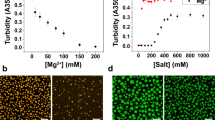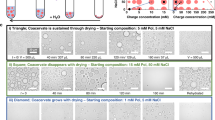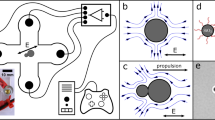Abstract
COACERVATES have been intensively investigated because of their presumed importance in the origin of life1; however, their electrical properties, representing many important processes, appear to have been relatively neglected. We have continued work by Bungenberg de Jong2 on the behaviour of coacervates in an alternating electric field, and effects similar to those reported by Heller and Texeira-Pinto3 and Füredi and Ohad4 on living cells have been observed.
This is a preview of subscription content, access via your institution
Access options
Subscribe to this journal
Receive 51 print issues and online access
$199.00 per year
only $3.90 per issue
Buy this article
- Purchase on Springer Link
- Instant access to full article PDF
Prices may be subject to local taxes which are calculated during checkout
Similar content being viewed by others
References
Oparin, A. I., The Origin of Life on the Earth, third ed. (Oliver and Boyd, Edinburgh, 1957).
Bungenberg de Jong, Colloid Science, 2 (Elsevier, New York, 1949).
Heller, J. H., and Texeira-Pinto, A. A., Nature, 183, 905 (1959).
Füredi, A. A., and Ohad, I., Biochim. Biophys. Acta, 79, 1 (1964).
Dervichian, D. G., and Magnant, C., Bull. Soc. Chem. Biol., 29, 660 (1947).
Schwan, H. P., Adv. Biol. Med. Phys., 5, 147 (1957).
Author information
Authors and Affiliations
Rights and permissions
About this article
Cite this article
SMITH, A., CHANCE, M. Coacervate Behaviour in an Alternating Electric Field. Nature 209, 74–75 (1966). https://doi.org/10.1038/209074a0
Issue Date:
DOI: https://doi.org/10.1038/209074a0
This article is cited by
-
Non-equilibrium conditions inside rock pores drive fission, maintenance and selection of coacervate protocells
Nature Chemistry (2022)
-
Non-equilibrium behaviour in coacervate-based protocells under electric-field-induced excitation
Nature Communications (2016)
-
Mechanism of Characteristic Behaviour of Cells in an Alternating Electric Field
Nature (1967)
Comments
By submitting a comment you agree to abide by our Terms and Community Guidelines. If you find something abusive or that does not comply with our terms or guidelines please flag it as inappropriate.



